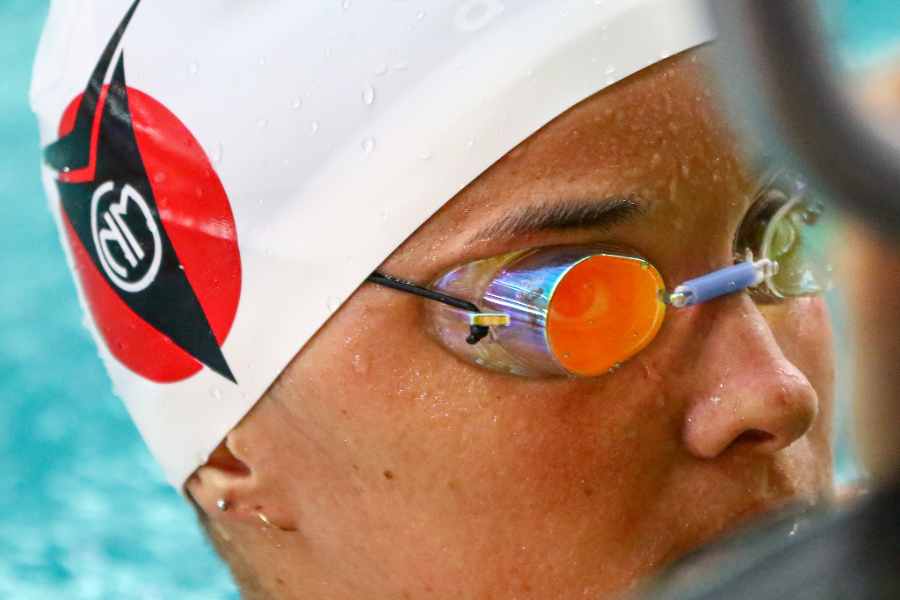There are a few steps that you should follow when putting on a swim cap. These include wetting the inside of the swim cap, avoiding elastic hair bands, and avoiding tightness.
If you’re having trouble putting on a silicone cap, try a latex or Lycra cap. If that still doesn’t work, you may have a size problem.
Putting on a swim cap
The first thing to do before putting on a swim cap is to make sure that you have the right size. A silicone cap should be loose enough to stretch over your head, but it shouldn’t be too tight.
Having someone hold the front of your hair down while you slip the cap over your head is an effective way to make the process easier. Alternatively, you can try a latex or Lycra swim cap if the silicone one is too tight for you.
The next step is to pull the cap down more. If you have long hair, you may want to restrain it with bobby pins. You should also avoid pointy hair accessories, as they can rip or tear a swim cap. Next, you should stretch the cap as wide as possible, but not too far, as it will cause it to rip or tear.
Avoiding elastic hair bands
Avoiding elastic hair bands when putting on your swim cap can make the whole process much easier. Using your fingers to pull your hair back and away from your neck can help you achieve this. Also, try to avoid wearing any earrings or sharp jewelry. It is also helpful to make sure your hair is wet before you put on your swim cap.
The main goal of any swim cap is to prevent tangles, and wet hair will make the application process go more smoothly. Children with hair that tends to tangle should also use conditioner before putting on their swim cap. But, it’s important to remember that an elastic hair band combined with a swim cap can cause a lot of discomfort for the child wearing it.
Wetting the inside of a swim cap
You can make your swim cap more secure by wetting the inside before you wear it. This will help the cap stick to your head and make a tight seal. Many Olympic swimmers will press down on their caps while they are wearing them to ensure that it does not slip off. This will help prevent any chlorine buildup from seeping through the cap.
Another way to prevent water from getting into your swim cap is to use waterproof earplugs. Ideally, a swimmer will wear earplugs that cover the entire ear. However, if you have hair tied in a ponytail, it may create an unusual shape and allow water to seep in.
Putting on a latex cap
Putting on a swim cap can be a bit tricky, especially if you have a lot of hair. Ponytailing your hair before you put the cap on can help keep your hair out of the way. However, if you are allergic to latex, you may want to avoid swimming with a swim cap that contains this substance.
The key to success with latex caps is to be careful when you put them on. Do not use metal clips or sharp objects to clip them on. You also want to avoid damaging your fingers by snagging them on the cap.
Putting on a neoprene cap
The neoprene swim cap is a great accessory to wear when swimming in cold water. It helps seal in heat and protects the head from wind and rain. In cold water, the human body loses 7 to 10 percent of its heat through the head. This can cause serious problems if swimmers don’t wear a swim cap.
First, place your hands inside the cap. Spread your fingertips to help you get the right fit. Stretch the cap a bit if you need to. It will return to its shape eventually. Next, slip it over your head until you reach the bottom of your ears. Make sure it is positioned correctly so that it doesn’t pinch or bind.
Protecting your ears with a swim cap
A swim cap can help protect your ears from water. Swim caps that are made of latex or silicone are water-tight. They prevent water from entering your ears and can prevent ear infections by blocking water from getting inside them. Using a swim cap with a chin strap can also help protect your ears. The chin strap pulls the material over the ears and keeps them from shifting.
Swimming caps do not completely protect your ears from water. While swim caps are useful and healthy, swimmers should still be careful about getting water in their ears. This water can stay inside your ears for days, which can lead to bacterial infections.
More Swim Cap Guides

Beau Cormier is a former NCAA I swimmer, US Open National finalist, and swim nerd. When not swimming or working for a data company, you can find him running the trails of the Pacific Northwest with his wife and dogs.
